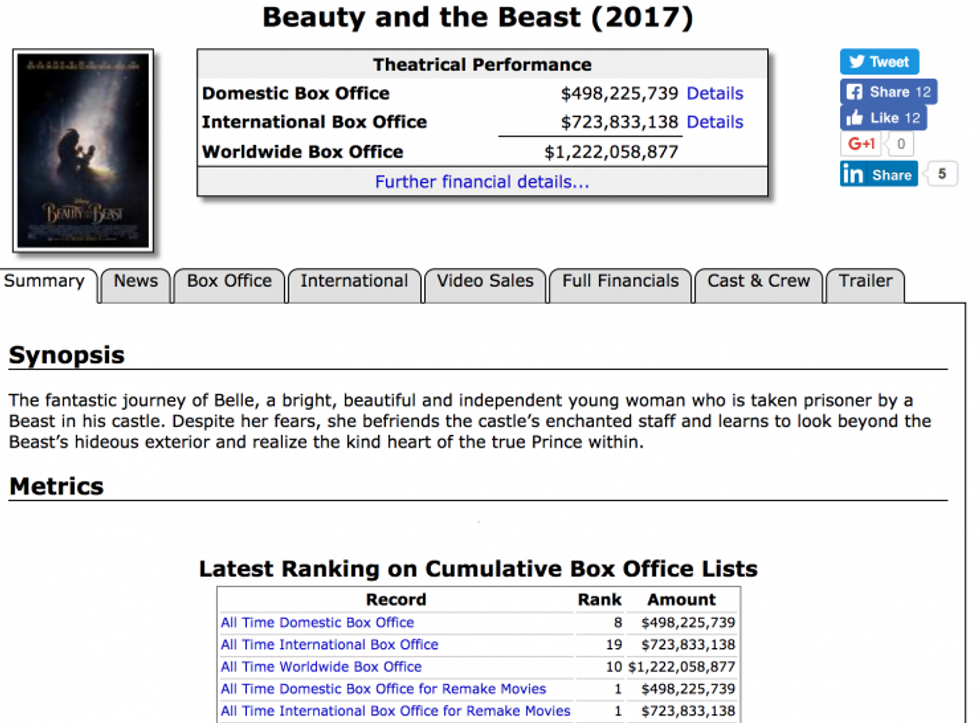10 Steps to Writing the Perfect Prospectus
Learn how to build a film prospectus that will have your investors asking "where do I sign?"

We've all heard that magical story of the prodigious young director whose short film festival premiere lands them an enthusiastic pre-sale from the day's hottest distributor. While we all dream of that scenario, it's likely that financing will not always be so easy. In the seemingly endless search for capital, a little business sense can go a long way.
When pitching to private equity investors, there's no question that the quality of your script is the most important thing. However, a strong prospectus is a crucial component that many first-time filmmakers don't have as firm a grasp on. In fact, a well researched, comprehensive prospectus—or business plan—can be the deciding factor in securing the funding for your next feature.
A good prospectus necessitates an understanding of where your project exists in the larger context of the industry.
You've got potential investors to agree to a meeting, you've pitched your film. What comes next? Follow up with a detailed prospectus that complements and expands upon your pitch. If all goes well, the next step is answering the question, "where do I sign?"
Writing out your business plan can also be extremely helpful for you in synthesizing exactly how your film will get made. A good prospectus necessitates an understanding of where your project exists in the larger context of the industry. It can be so easy to get caught up in your "vision" and only consider your film in a bubble. But writing out your strategies and intent will force that bubble to pop, in a good way.
Below are 10 important tips to writing the perfect prospectus.
1. Organize your flow
The first step is outlining your document. Use your storytelling intuition to feel out a good flow for the sections. Imagine an investor reading it front to back; what's the best way to get them in an enthusiastic mindset? This will vary depending on your resources and level of production—you should highlight what you have, and downplay what you don't—but a good general layout is as follows:
- Title sheet with legal disclaimer
- Project overview (one page)
- Intent
- Capital requirements
- Brief production timeline
- Summarized business strategy
- About the film
- Logline
- Synopsis
- Director's statement
- Character breakdown (leads only)
- Marketing
- Audience
- Genre
- Comparable film examples
- Business strategy
- Production overview
- Location
- Detailed timeline
- Resources
- Team
- Cast
- Investor Information
- Incentives
- Deal structure
- Budget top sheet
- Revenue models
- Revenue projections
2. Boast your credentials
As an indie production, you may not be able to build as impressive a prospectus as the next Tarantino film, but that's okay. As you go through your outline, identify where your project can stand out.
Do not be ashamed to work every single angle.
What makes your film special? And what makes it a good bet? If your film is based on a true story, consider including a well written director's statement about its origins. If you have a particularly outstanding team, think about how you can make your crew pages shine.
The same goes for any resources your production might have. Are there already great actors attached? Do you have access to an awe-inspiring location? Highlight all of it. Do not be ashamed to work every single angle.
3. Define your market niche
Clearly defining where your film falls in the market will serve your production in innumerable ways. It will guide you in targeting both grants and private equity, during difficult scenes on set, through your edit, and all the way to your home video release. And defining it early shows investors that you have good marketing sense. Think of your niche as the sales version of your theme.
Don't stop at naming your genre and demographics. Really make sure to have a rounded understanding of how to capitalize on them. How do 7-15 year-old girls consume movies as opposed to senior citizens? Which genres have the highest box office performance? The more you can outline your business strategy from the very beginning, the more confidence you will inspire.
You can also use this area to show off your knowledge of the industry. Make mention of the various avenues of distribution available to films these days, and display an understanding of the pros and cons for each. If you don't know these things right now, Google, Google, Google. So much information is available online about every aspect of production (especially here at NFS). And when you're done Googling, call every professional you know and ask them too.
4. Know your investor perks & work 'em
At the end of the day, very few investors are writing checks out of the goodness of their hearts, so make sure to emphasize what's in it for them. Research the tax incentives available in your shooting location. Many regions will offer a tax rebate in exchange for shooting there. Considering that's the first income your film will earn, your investors will want to know about it. A 30% guaranteed rebate makes their investment 30% more secure. Unfortunately, film's biggest federal tax boon—Section 181—has expired. But since it's frequently renewed, know how it works and keep an eye out for its reemergence.
Other incentives will be based on your deal structure. Traditionally, investors recoup their initial money, as well as an additional 10-20%, before anyone else makes profit. Especially if you are pitching to non-film people, which many of you will be, make sure everyone's on the same page about how this works. Depending on your target investor demographic, you may want to tailor your language throughout the prospectus in a way that will be most suitable to them.
On-screen credits can be an enormous motivator to investors. Who wouldn't want to see their name on the silver screen? You can offer a sliding scale of titles all the way from "Thank you" to Executive Producer. Just be careful throwing producer credits around; you wouldn't want someone writing you a $50 check and expecting creative approvals in exchange.

5. Don't be shy about the risks
On the flip side of incentives, it's important to admit the risks involved with film investment. And legally, it protects you to do so. Anyone considering a major financial investment should be made aware that film is never a sure bet.
A movie's financial success is subject to many, many variables that are out of anyone's hands. Sometimes, a weekend box office performance depends on the weather. Sometimes a huge movie opens against yours. Sometimes, there's a global event that distracts audience members from the industry entirely. It's just too hard to tell.
You don't have to make a big deal out of this risk language in your prospectus, but having it there acknowledges the uncertainties and shows your investors that you are not naive.
6. Research comps
Do your homework. Find 3-6 films with similar genre, tone, story, and scope to yours and learn their histories. How were they made? Who produced them? How did they get funding? And how did they perform? Try to determine any common factors in their success and consider how you can replicate those factors. Did they all premiere at a top tier festival? Did they all have a relatively well known actor?
Once you've identified these comparable films, find a way to tell their stories in your prospectus. Succinctly explain how they relate to your project and outline their successes in a way that inspires confidence. As much as you may want your film to be novel on the scene, investors want to see that it's been done before, and well. So do both. Spend your story portion explaining why your narrative is unique, and then show why the back end is structurally tried and true.

7. Finally, get some cold hard numbers
Once you've got your comp films in order, you'll want to translate them into revenue models. Look up each film's performance on The Numbers and Box Office Mojo. You should be able to find the screen count, number of weeks, and weekly box office for each. Put some or all of this info into tables for your investors to see.
Then, using some guesswork and your comp films as reference, build the same table for your film. Estimate the number of screens, weeks, and revenue. It's best to do this three times, generating low, medium, and high estimates. These are your revenue projections.
Obviously you know—and your investors will know from your risk language—that it's impossible to truly say how much a film will make. But these tables are all about creating context and managing expectations. Depending on who is reading your business plan, these models and projections can be just as important for explaining the market as your business strategy.
Having an appropriately designed prospectus shows that you know how to brand.
8. Design with intention
Once you have all your text ready, it's time to design. Having an appropriately designed prospectus shows that you know how to brand; film is a visual medium after all. But don't go too crazy, this is a business document and should be professional. Save most of the creative world-building for your pitch deck. (Your "pitch deck," sometimes called a "look book," is a more visual, story-based, and succinct version of this information meant as a supplement to pitch meetings.)
A perfect balance of professional-yet-aesthetic can be found using tastefully minimal reference images, tonally relevant fonts, and a cohesive color palette. You should work with a designer to identify and implement these assets. But ultimately, your branding style should be rooted in your story, and only you can decide the direction it will take. So take some time to think about the world of your movie and its genre. Study what similar films (including your comps) have done in the past. Maybe spend some time on Pinterest.
Whatever design you land on should communicate your film's genre and tone at first glance. Achieving this will show your investors that you have a strong directorial voice, a necessary component for gaining their confidence.
9. Get legal protection
Another very important step in completing your prospectus is getting a legal seal of approval. Before sending anything out to potential investors, we highly recommend getting an entertainment lawyer on your side.
There are good and bad ways to cut costs when making an indie feature, and legal protection is definitely not somewhere to skimp. Your attorney will prove invaluable throughout the entire production process.
Don't know where to find one? Digging through the "legal counsel" credits on IMDB is a good place to start. You can generally reach out to these firms and negotiate a retainer based on your available capital. Trust us when we say that it's money well spent.
Once your legal team is on board, they can guide you through the harrier parts of your prospectus. They may even be helpful in drawing up language for certain sections. Once your document is drafted, make sure your lawyers review the entire thing. At minimum, your prospectus should do the following: identify you as an LLC, have a legal disclaimer at the top, avoid any firm financial promises, and contain risk language.
Attached to your prospectus should be an investor agreement or PPM (depending on your film's size), which your legal team will provide. And if you haven't formed an LLC yet, they can help you with that too.
10. Get varied feedback
So your prospectus is written and designed and legally iron-clad, awesome! But there's one more step before you send it out into the wide ocean of investors. Make a diverse list of around 5-10 friends and colleagues who can offer you feedback on your document. This list should roughly represent the pool of investors you're seeking out, in profession, age, gender, geographic and socio-economic status. These friends will be your beta-testers. (And some may even offer your first funds!) Have them review your prospectus, with as little context as possible, and give you any and all thoughts on it. Adjust accordingly.
You may not have close friends that match all these criteria. In fact, not many people have access to executive producer level types, but try your best. Ultimately, the world of pitching is just as varied as the rest of the industry. You never know what you're going to get when you walk into a room. So seek out all the friendly advice you can, and after that, just jump!
And remember, if no one funds your film this time around, don't let that stop you. Just as distribution is constantly evolving, so is film financing. Self funded projects are increasingly easy to execute, and crowdsourcing platforms like Kickstarter are becoming a more viable option for feature films every day. No matter how your film gets made, you won't regret writing this document. A film's prospectus is an essential road map for the whole team.
NOTE: There are differences between "prospectuses" and "business plans," but in the indie film world, they can be used interchangeably.

 No Film School's coverage of
No Film School's coverage of 









